Assessing Ecological Impacts and Recovery in Coal Mining Areas: A Remote Sensing and Field Data Analysis in Northwest China
Abstract
1. Introduction
2. Materials and Methods
2.1. Study Area
2.2. Data Sources
2.2.1. Satellite Imagery
- DEM: The Shuttle Radar Topography Mission (SRTM) DEM was generated using radar instruments that were mounted on the Space Shuttle Endeavour, which during an 11-day mission in February 2000, emitted radar pulses to map the Earth’s land elevations. This research utilizes DEMs from SRTM, specifically collected during this February 2000 mission, prior to the mining activities, alongside the 2022 UAV DEM for terrain assessment. These DEMs are vital for calculating slopes, aspects, surface roughness [28], and terrain relief [29], serving as analytical parameters to explore the topographic changes pre- and post-extraction activities.
- Landsat Data: The study utilizes multi-temporal Landsat 8 imagery, supplemented by Landsat 7 as needed, covering the period from 2013 to 2022. To minimize seasonal effects on vegetation status, images were collected during the peak vegetation growth season, from July to September. A Google Earth Engine (GEE)-based cloud detection algorithm was used to filter out images with over 10% cloud cover, resulting in the selection of up to 54 images with minimal cloud interference. These images offer a 16-day temporal resolution and a 30-m spatial resolution. All data were sourced from the USGS website (https://glovis.usgs.gov/, accessed on 1 January 2024). Given that the Landsat 7 Enhanced Thematic Mapper Plus (ETM+) sensor experienced a scan line corrector (SLC) malfunction in 2003, leading to data gaps and reduced usability, the study primarily relies on Landsat 8 imagery. However, in instances where Landsat 8 data encountered issues, data fusion techniques were employed to combine Landsat 7 and Landsat 8 imagery. This approach leveraged the higher quality and continuity of Landsat 8 data to supplement and correct the Landsat 7 data, ensuring consistency and reliability in the combined dataset.
2.2.2. Unmanned Aerial Vehicle (UAV) Data
2.2.3. Soil Data
2.3. Methods
2.3.1. The Impact of Erlintu Coal Mine Exploitation on Topographic Factors
2.3.2. Crack Extraction
2.3.3. The Construction of NDVI, VFC, and RSEI
2.3.4. Classification Method of Evolution Trend of VFC
2.3.5. Collection and Detection of Soil Samples
3. Results
3.1. Periodic Impact of Erlintu Coal Mine Exploitation on Topographic Factors
3.2. Using UAVs to Monitor Ground Fissures and Ecological Recovery Processes in Mining Areas
3.3. Assessing Vegetation Dynamics in Response to Mining Activities through Satellite Imagery
3.3.1. Analysis of NDVI Variations in the Trial Region
3.3.2. Analysis of Changes in VFC in the Trial Region
3.3.3. Analysis of RSEI Variations in the Erlintu Coal Mine-Affected Area
3.4. Impact Characteristics of Coal Shaft Mining on Soil’s Physicochemical Properties
4. Discussion
4.1. Analysis of Cyclical Vegetation Response to Mining Disturbances
4.2. Impact of Mining Activities on Terrain and Crack
4.3. Impact of Mining Activities on Soil
5. Conclusions
Author Contributions
Funding
Data Availability Statement
Acknowledgments
Conflicts of Interest
References
- Hu, Z.; Xiao, W. Optimization of concurrent mining and reclamation plans for single coal seam: A case study in northern Anhui, China. Environ. Earth Sci. 2013, 68, 1247–1254. [Google Scholar] [CrossRef]
- Li, S. Countermeasures for the Main Ecological Problems Resulted from Western Coal Development. In Coal Preparation Technology; Springer: Cham, Switzerland, 2003; pp. 1–3. [Google Scholar]
- Li, W. Metallogenic geological characteristics and newly discovered orebodies in Northwest China. Geol. China 2015, 42, 365–380. [Google Scholar]
- Tang, Q.; Wang, J.; Jing, Z.; Yan, Y.; Niu, H. Response of ecological vulnerability to land use change in a resource-based city, China. Resour. Policy 2021, 74, 102324. [Google Scholar] [CrossRef]
- Cui, F.; Du, Y.; Ni, J.; Zhao, Z.; Peng, S. Effect of Shallow-Buried High-Intensity Mining on Soil Water Content in Ningtiaota Minefield. Water 2021, 13, 361. [Google Scholar] [CrossRef]
- Du, Y.; Yan, S.; Zhao, F.; Chen, D.; Zhang, H. DS-InSAR Based Long-Term Deformation Pattern Analysis in the Mining Region with an Improved Phase Optimization Algorithm. Front. Environ. Sci. 2022, 10, 799946. [Google Scholar] [CrossRef]
- Boldy, R.; Santini, T.; Annandale, M.; Erskine, P.D.; Sonter, L.J. Understanding the impacts of mining on ecosystem services through a systematic review. Extr. Ind. Soc. 2021, 8, 457–466. [Google Scholar] [CrossRef]
- Omuto, C.T.; Vargas, R.R.; Alim, M.S.; Paron, P. Mixed-effects modelling of time series NDVI-rainfall relationship for detecting human-induced loss of vegetation cover in drylands. J. Arid Environ. 2010, 74, 1552–1563. [Google Scholar] [CrossRef]
- Zhang, Q.; Ma, J.; Yang, Y.; Luo, Z.; Wang, Y.; Chen, F. Mining Subsidence-Induced Microtopographic Effects Alter the Interaction of Soil Bacteria in the Sandy Pasture, China. Front. Environ. Sci. 2021, 9, 656708. [Google Scholar] [CrossRef]
- Jones, H.G.; Vaughan, R.A. Remote Sensing of Vegetation: Principles, Techniques, and Applications; Oxford University Press: Oxford, MS, USA, 2010. [Google Scholar]
- Xiao, W.; Ren, H.; Sui, T.; Zhang, H.; Zhao, Y.; Hu, Z. A drone- and field-based investigation of the land degradation and soil erosion at an opencast coal mine dump after 5 years’ evolution of natural processes. Int. J. Coal Sci. Technol. 2022, 9, 42. [Google Scholar] [CrossRef]
- Li, J.; Pei, Y.; Zhao, S.; Xiao, R.; Sang, X.; Zhang, C. A review of remote sensing for environmental monitoring in China. Remote Sens. 2020, 12, 1130. [Google Scholar] [CrossRef]
- Dronova, I.; Taddeo, S. Remote sensing of phenology: Towards the comprehensive indicators of plant community dynamics from species to regional scales. J. Ecol. 2022, 110, 1460–1484. [Google Scholar] [CrossRef]
- Musick, H.B.; Pelletier, R.E. Response to soil moisture of spectral indexes derived from bidirectional reflectance in thematic mapper wavebands. Remote Sens. Environ. 1988, 25, 167–184. [Google Scholar] [CrossRef]
- Abah, R.C.; Petja, B.M. Evaluation of organic carbon, available phosphorus, and available potassium as a measure of soil fertility. Merit Res. J. Agric. Sci. Soil Sci. 2015, 3, 159–167. [Google Scholar]
- Xu, Y.; Wang, X.; Bai, J.; Wang, D.; Wang, W.; Guan, Y. Estimating the spatial distribution of soil total nitrogen and available potassium in coastal wetland soils in the Yellow River Delta by incorporating multi-source data. Ecol. Indic. 2020, 111, 106002. [Google Scholar] [CrossRef]
- Yengoh, G.T.; Dent, D.; Olsson, L.; Tengberg, A.E.; Tucker, C.J., III. Use of the Normalized Difference Vegetation Index (NDVI) to Assess Land Degradation at Multiple Scales: Current Status, Future Trends, and Practical Considerations; Springer: Berlin/Heidelberg, Germany, 2015. [Google Scholar]
- Gillies, R.R.; Carlson, T.N. Thermal Remote Sensing of Surface Soil Water Content with Partial Vegetation Cover for Incorporation into Climate Models. J. Appl. Meteorol. 1995, 34, 745–756. [Google Scholar] [CrossRef]
- Xu, H.; Xu, F.; Lin, T.; Xu, Q.; Yu, P.; Wang, C.; Aili, A.; Zhao, X.; Zhao, W.; Zhang, P.; et al. A systematic review and comprehensive analysis on ecological restoration of mining areas in the arid region of China: Challenge, capability and reconsideration. Ecol. Indic. 2023, 154, 110630. [Google Scholar] [CrossRef]
- Xu, H.; Wang, Y.; Guan, H.; Shi, T.; Hu, X. Detecting Ecological Changes with a Remote Sensing Based Ecological Index (RSEI) Produced Time Series and Change Vector Analysis. Remote Sens. 2019, 11, 2345. [Google Scholar] [CrossRef]
- Hu, X.; Xu, H. A new remote sensing index for assessing the spatial heterogeneity in urban ecological quality: A case from Fuzhou City, China. Ecol. Indic. 2018, 89, 11–21. [Google Scholar] [CrossRef]
- Zheng, Z.; Wu, Z.; Chen, Y.; Guo, C.; Marinello, F. Instability of remote sensing based ecological index (RSEI) and its improvement for time series analysis. Sci. Total Environ. 2022, 814, 152595. [Google Scholar] [CrossRef]
- He, Y.; He, X.; Liu, Z.; Zhao, S.; Bao, L.; Li, Q.; Yan, L. Coal Mine Subsidence has Limited Impact on Plant Assemblages in an Arid and Semi-Arid Region of Northwestern China. Ecoscience 2017, 24, 91–103. [Google Scholar] [CrossRef]
- Liu, S.; Li, W.; Qiao, W.; Wang, Q.; Hu, Y.; Wang, Z. Effect of natural conditions and mining activities on vegetation variations in arid and semiarid mining regions. Ecol. Indic. 2019, 103, 331–345. [Google Scholar] [CrossRef]
- Ma, K.; Zhang, Y.; Ruan, M.; Guo, J.; Chai, T. Land Subsidence in a Coal Mining Area Reduced Soil Fertility and Led to Soil Degradation in Arid and Semi-Arid Regions. Int. J. Environ. Res. Public Health 2019, 16, 3929. [Google Scholar] [CrossRef] [PubMed]
- Mi, J.; Yang, Y.; Hou, H.; Zhang, S.; Raval, S.; Chen, Z.; Hua, Y. The long-term effects of underground mining on the growth of tree, shrub, and herb communities in arid and semiarid areas in China. Land Degrad. Dev. 2021, 32, 1412–1425. [Google Scholar] [CrossRef]
- Miller, H.J. Tobler’s first law and spatial analysis. Ann. Assoc. Am. Geogr. 2004, 94, 284–289. [Google Scholar] [CrossRef]
- Stout, K.J. Surface roughness ∼ measurement, interpretation and significance of data. Mater. Des. 1981, 2, 260–265. [Google Scholar] [CrossRef]
- Pike, R.J.; Wilson, S.E. Elevation-Relief Ratio, Hypsometric Integral, and Geomorphic Area-Altitude Analysis. Geol. Soc. Am. Bull. 1971, 82, 1079–1084. [Google Scholar] [CrossRef]
- Meinen, B.U.; Robinson, D.T. Mapping erosion and deposition in an agricultural landscape: Optimization of UAV image acquisition schemes for SfM-MVS. Remote Sens. Environ. 2020, 239, 111666. [Google Scholar] [CrossRef]
- Lowe, D.G. Distinctive image features from scale-invariant keypoints. Int. J. Comput. Vis. 2004, 60, 91–110. [Google Scholar] [CrossRef]
- Hirschmuller, H. Stereo Processing by Semiglobal Matching and Mutual Information. IEEE Trans. Pattern Anal. Mach. Intell. 2008, 30, 328–341. [Google Scholar] [CrossRef]
- Triggs, B.; Mclauchlan, P.F.; Hartley, R.I.; Fitzgibbon, A.W. Bundle Adjustment: A Modern Synthesis; Springer: Berlin, Germany, 2000; pp. 298–372. [Google Scholar]
- Smith, M.J.; Pain, C.F. Applications of remote sensing in geomorphology. Prog. Phys. Geogr. Earth Environ. 2009, 33, 568–582. [Google Scholar] [CrossRef]
- Toutin, T. Review article: Geometric processing of remote sensing images: Models, algorithms and methods. Int. J. Remote Sens. 2004, 25, 1893–1924. [Google Scholar] [CrossRef]
- Szeliski, R. Image Alignment and Stitching: A Tutorial. Found. Trends® Comput. Graph. Vis. 2007, 2, 1–104. [Google Scholar] [CrossRef]
- Wang, Y.; Zhu, X.; Wu, B. Automatic detection of individual oil palm trees from UAV images using HOG features and an SVM classifier. Int. J. Remote Sens. 2019, 40, 7356–7370. [Google Scholar] [CrossRef]
- Zhang, F.; Hu, Z.; Yang, K.; Fu, Y.; Feng, Z.; Bai, M. The Surface Crack Extraction Method Based on Machine Learning of Image and Quantitative Feature Information Acquisition Method. Remote Sens. 2021, 13, 1534. [Google Scholar] [CrossRef]
- Zhang, F.; Hu, Z.; Liang, Y.; Li, Q. Evaluation of Surface Crack Development and Soil Damage Based on UAV Images of Coal Mining Areas. Land 2023, 12, 774. [Google Scholar] [CrossRef]
- Tucker, C.J. Red and photographic infrared linear combinations for monitoring vegetation. Remote Sens. Environ. 1979, 8, 127–150. [Google Scholar] [CrossRef]
- Jiang, Z.; Huete, A.R.; Chen, J.; Chen, Y.; Li, J.; Yan, G.; Zhang, X. Analysis of NDVI and scaled difference vegetation index retrievals of vegetation fraction. Remote Sens. Environ. 2006, 101, 366–378. [Google Scholar] [CrossRef]
- Pettorelli, N.; Vik, J.O.; Mysterud, A.; Gaillard, J.; Tucker, C.J.; Stenseth, N.C. Using the satellite-derived NDVI to assess ecological responses to environmental change. Trends Ecol. Evol. 2005, 20, 503–510. [Google Scholar] [CrossRef] [PubMed]
- Carlson, T.N.; Ripley, D.A. On the relation between NDVI, fractional vegetation cover, and leaf area index. Remote Sens. Environ. 1997, 62, 241–252. [Google Scholar] [CrossRef]
- Zawadzki, J.; Przeździecki, K.; Miatkowski, Z. Determining the area of influence of depression cone in the vicinity of lignite mine by means of triangle method and LANDSAT TM/ETM+ satellite images. J. Environ. Manag. 2016, 166, 605–614. [Google Scholar] [CrossRef]
- Xu, H. A new index for delineating built-up land features in satellite imagery. Int. J. Remote Sens. 2008, 29, 4269–4276. [Google Scholar] [CrossRef]
- Essa, W.; Verbeiren, B.; van der Kwast, J.; Van de Voorde, T.; Batelaan, O. Evaluation of the DisTrad thermal sharpening methodology for urban areas. Int. J. Appl. Earth Obs. Geoinf. 2012, 19, 163–172. [Google Scholar] [CrossRef]
- Jimenez-Munoz, J.C.; Cristobal, J.; Sobrino, J.A.; Soria, G.; Ninyerola, M.; Pons, X.; Pons, X. Revision of the Single-Channel Algorithm for Land Surface Temperature Retrieval from Landsat Thermal-Infrared Data. IEEE Trans. Geosci. Remote Sens. 2009, 47, 339–349. [Google Scholar] [CrossRef]
- Lide, D.R. CRC Handbook of Chemistry and Physics; CRC Press: Boca Raton, FL, USA, 2004. [Google Scholar]
- Ahluwalia, V.K. Instrumental Methods of Chemical Analysis; Springer: Berlin/Heidelberg, Germany, 2023. [Google Scholar]
- Brabson, J.A. The Kjeldahl Method for Organic Nitrogen; Oxford University Press: Oxford, UK, 1966. [Google Scholar]
- Olsen, P.S.; Cole, C.V.; Watanabe, F.S.; Dean, L.A. Estimation of Available Phosphorus in Soils by Extraction with Sodium Bicarbonate; USDA Circular No. 939; US Department of Agriculture: Washington, DC, USA, 1954.
- Christian, G.D.; Epstein, M.S. Atomic Absorption Spectroscopy; Springer: Berlin/Heidelberg, Germany, 1980. [Google Scholar]
- Black, C.A. Soil Fertility Evaluation and Control; CRC Press: Boca Raton, FL, USA, 2013. [Google Scholar]
- Carter, M.R.; Gregorich, E.G. Soil Sampling and Methods of Analysis; CRC Press: Boca Raton, FL, USA, 2007. [Google Scholar]
- Liu, Y.; Lei, S.; Chen, X.; Chen, M.; Zhang, X.; Long, L. Study of plant configuration pattern in guided vegetation restoration: A case study of semiarid underground mining areas in Western China. Ecol. Eng. 2021, 170, 106334. [Google Scholar] [CrossRef]
- Song, D.; Hu, Z.; Zeng, J.; Sun, H. Influence of mining on vegetation in semi-arid areas of western China based on the coupling of above ground and below ground—A case study of Daliuta coalfield. Ecol. Indic. 2024, 161, 111964. [Google Scholar] [CrossRef]
- Agboola, O.; Babatunde, D.E.; Isaac Fayomi, O.S.; Sadiku, E.R.; Popoola, P.; Moropeng, L.; Yahaya, A.; Mamudu, O.A. A review on the impact of mining operation: Monitoring, assessment and management. Results Eng. 2020, 8, 100181. [Google Scholar] [CrossRef]
- Harwood, T.D.; Donohue, R.J.; Williams, K.J.; Ferrier, S.; McVicar, T.R.; Newell, G.; White, M. Habitat Condition Assessment System: A new way to assess the condition of natural habitats for terrestrial biodiversity across whole regions using remote sensing data. Methods Ecol. Evol. 2016, 7, 1050–1059. [Google Scholar] [CrossRef]
- Marttila, M.; Louhi, P.; Huusko, A.; Mäki Petäys, A.; Yrjänä, T.; Muotka, T. Long-term performance of in-stream restoration measures in boreal streams. Ecohydrology 2016, 9, 280–289. [Google Scholar] [CrossRef]
- Latifovic, R.; Fytas, K.; Chen, J.; Paraszczak, J. Assessing land cover change resulting from large surface mining development. Int. J. Appl. Earth Obs. Geoinf. 2005, 7, 29–48. [Google Scholar] [CrossRef]
- Thompson, J.A.; Bell, J.C.; Butler, C.A. Digital elevation model resolution: Effects on terrain attribute calculation and quantitative soil-landscape modeling. Geoderma 2001, 100, 67–89. [Google Scholar] [CrossRef]
- Monger, C.; Sala, O.E.; Duniway, M.C.; Goldfus, H.; Meir, I.A.; Poch, R.M.; Throop, H.L.; Vivoni, E.R. Legacy effects in linked ecological–soil–geomorphic systems of drylands. Front. Ecol. Environ. 2015, 13, 13–19. [Google Scholar] [CrossRef] [PubMed]
- Swanson, F.J.; Kratz, T.K.; Caine, N.; Woodmansee, R.G. Landform effects on ecosystem patterns and processes. Bioscience 1988, 38, 92–98. [Google Scholar] [CrossRef]
- Amare, S.; Keesstra, S.; van der Ploeg, M.; Langendoen, E.; Steenhuis, T.; Tilahun, S. Causes and controlling factors of Valley bottom Gullies. Land 2019, 8, 141. [Google Scholar] [CrossRef]
- Weintraub, L. To Life! Eco Art in Pursuit of a Sustainable Planet; University of California Press: Berkeley, CA, USA, 2012. [Google Scholar]
- Wick, A.F. Soil Aggregate and Organic Matter Dynamics in Reclaimed Mineland Soils; University of Wyoming: Laramie, WY, USA, 2007. [Google Scholar]
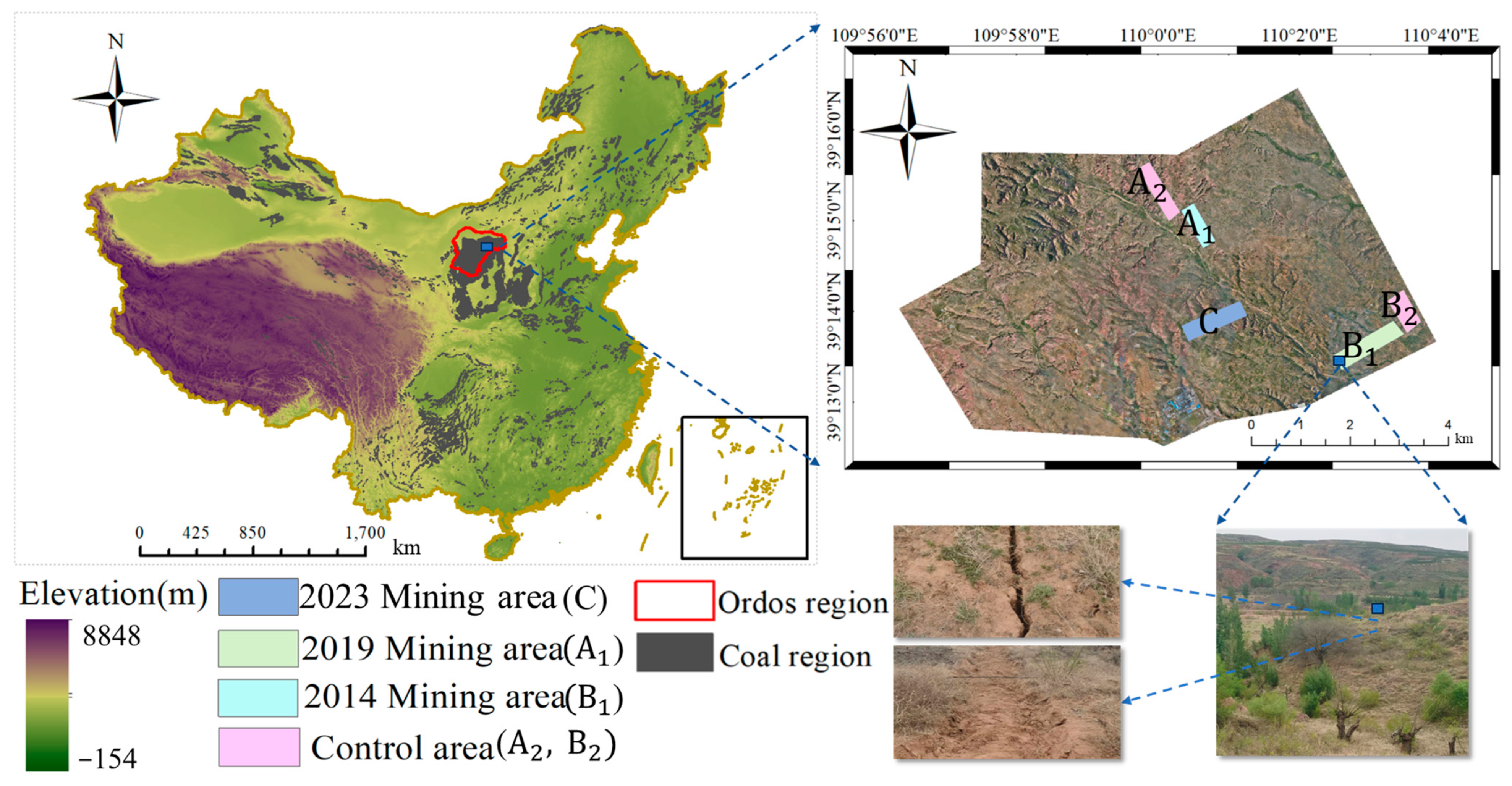
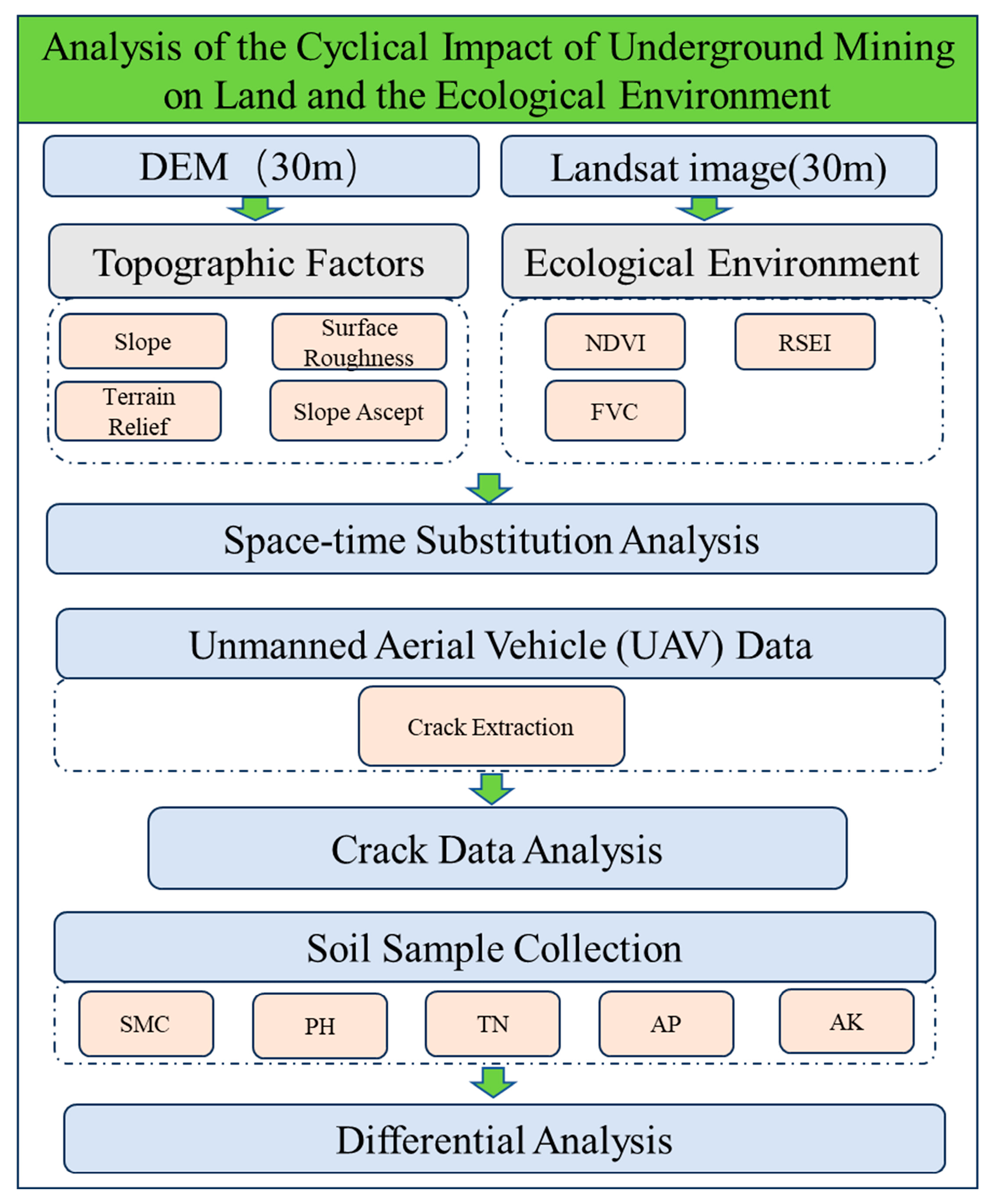
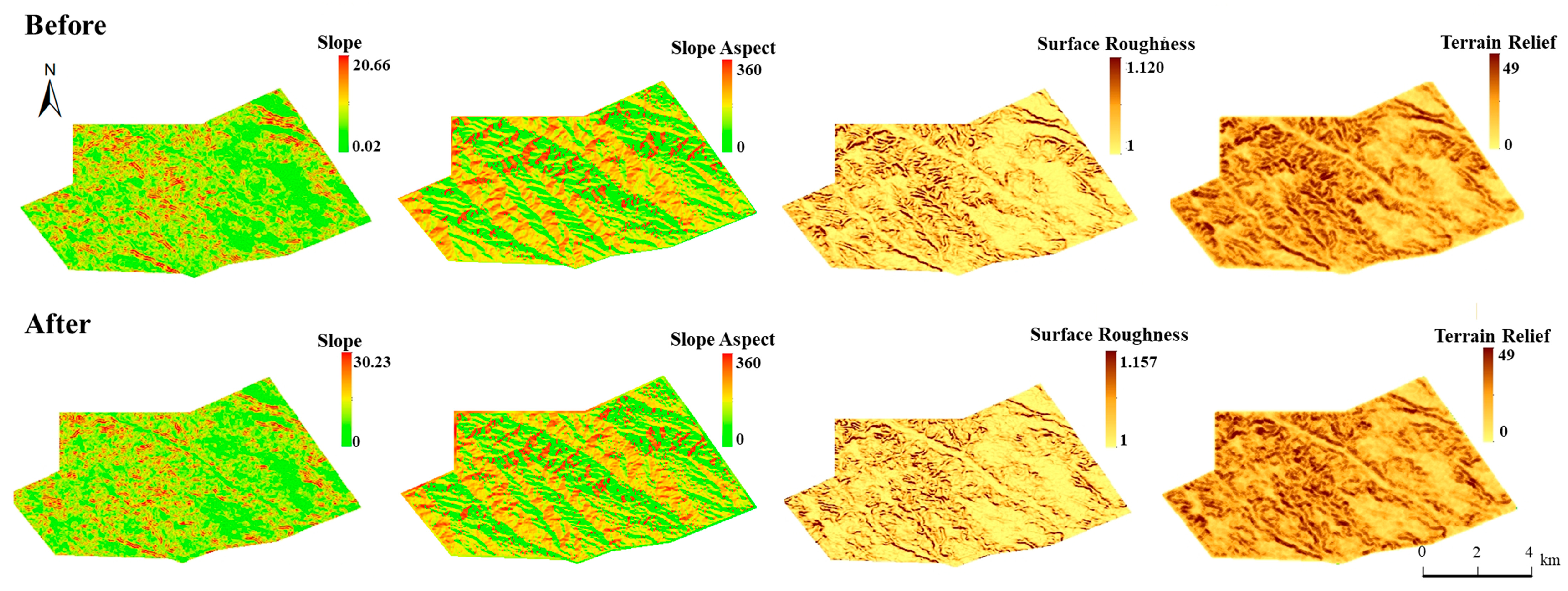

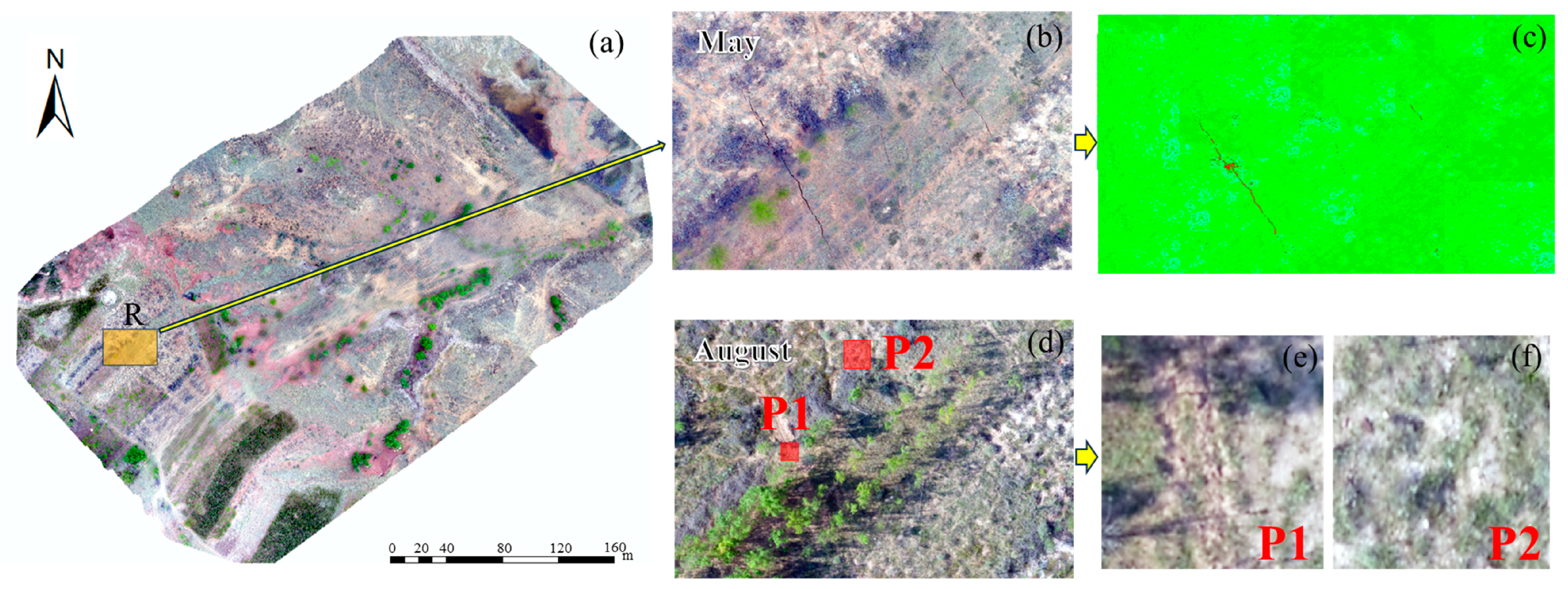


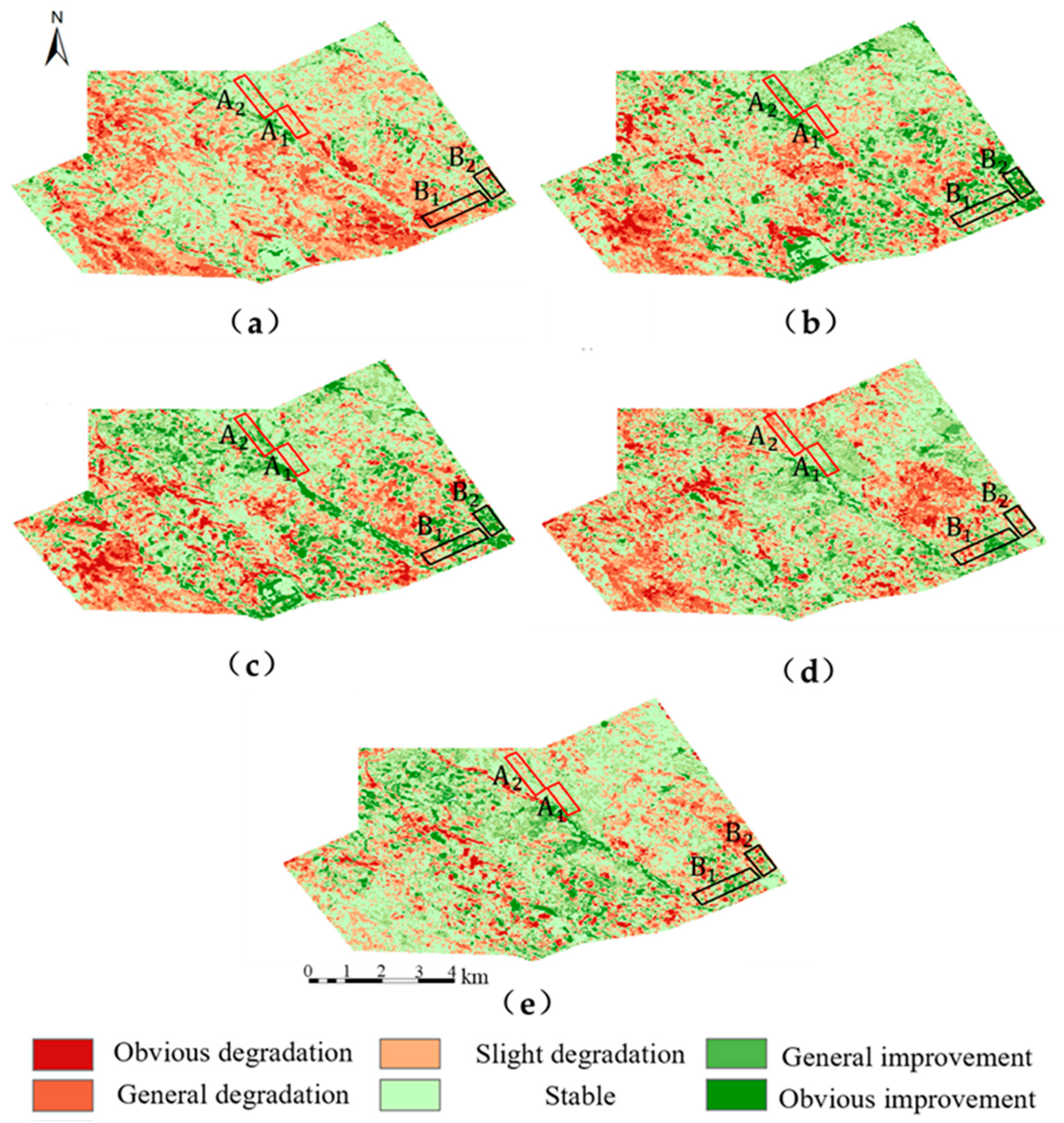
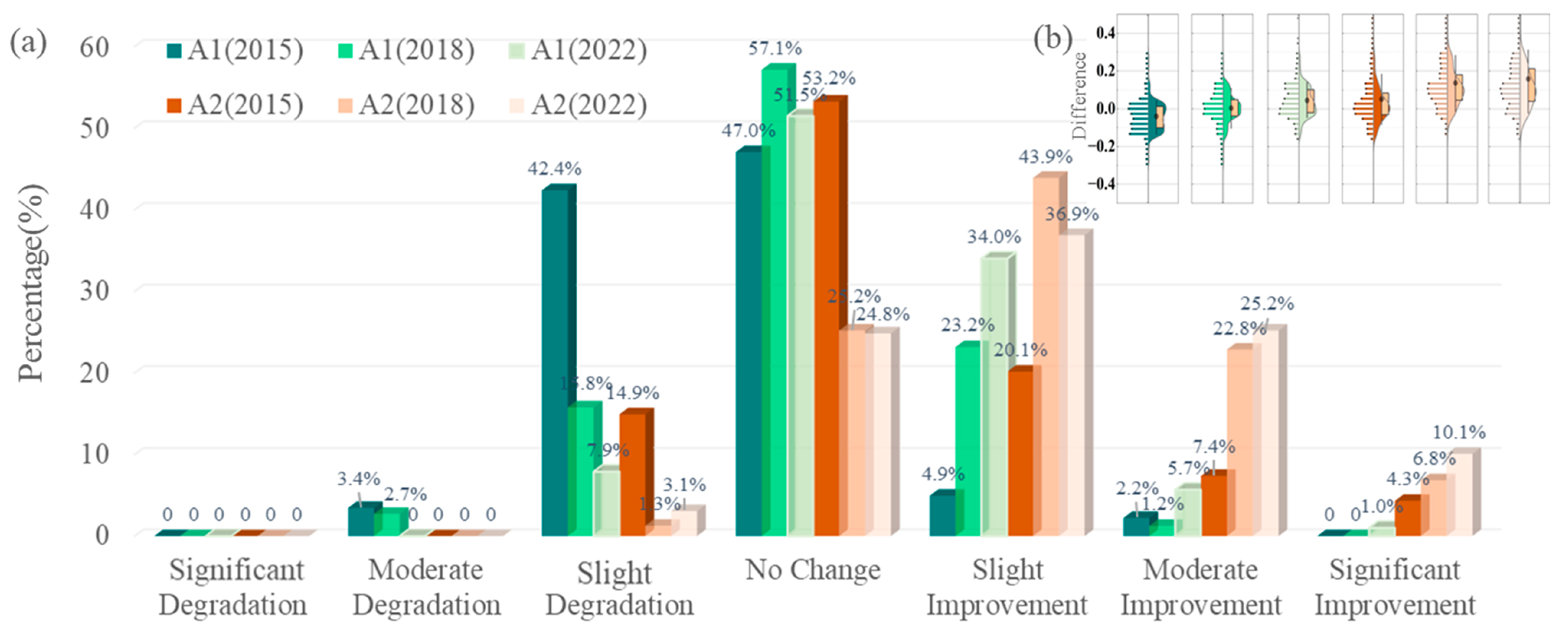

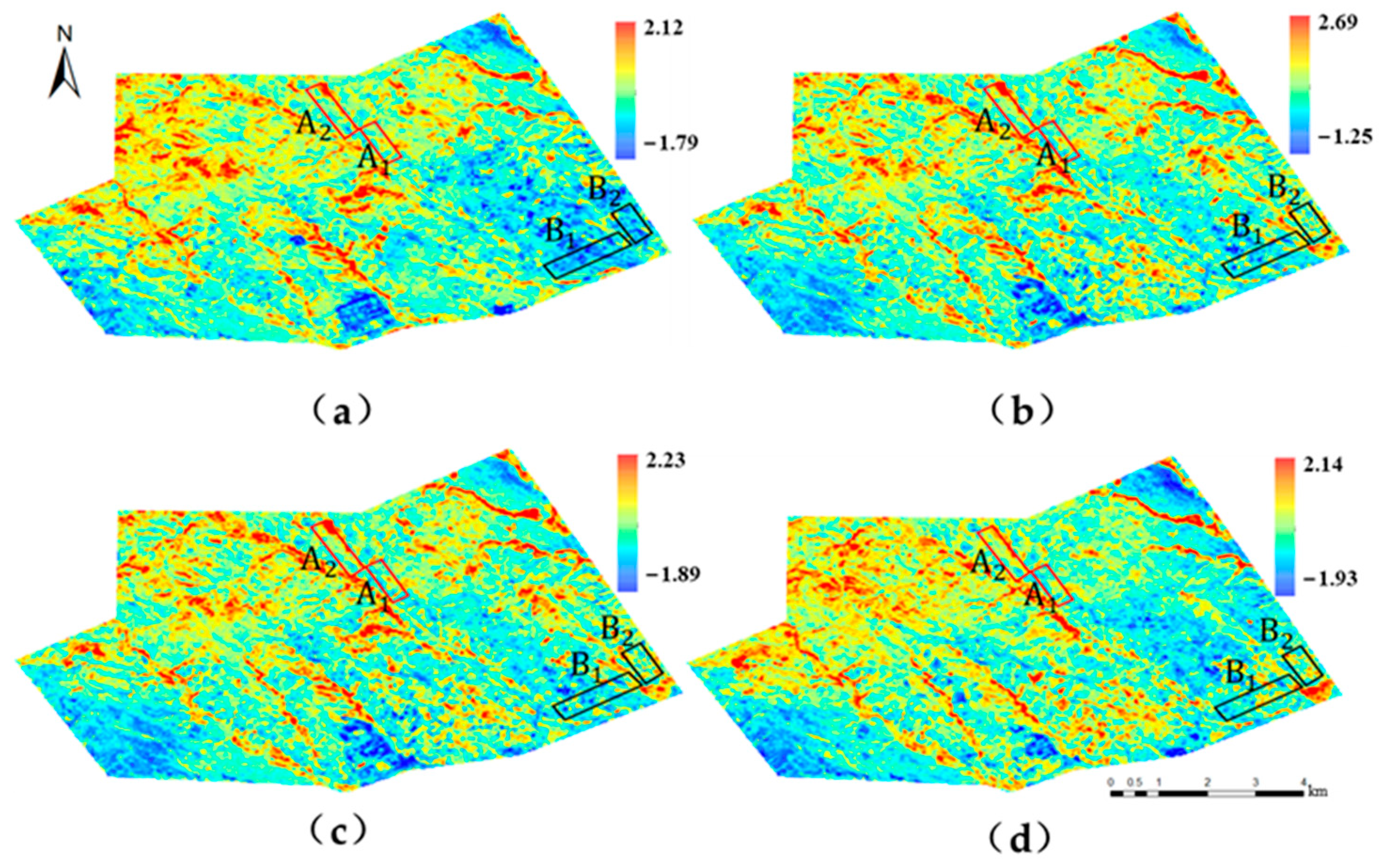
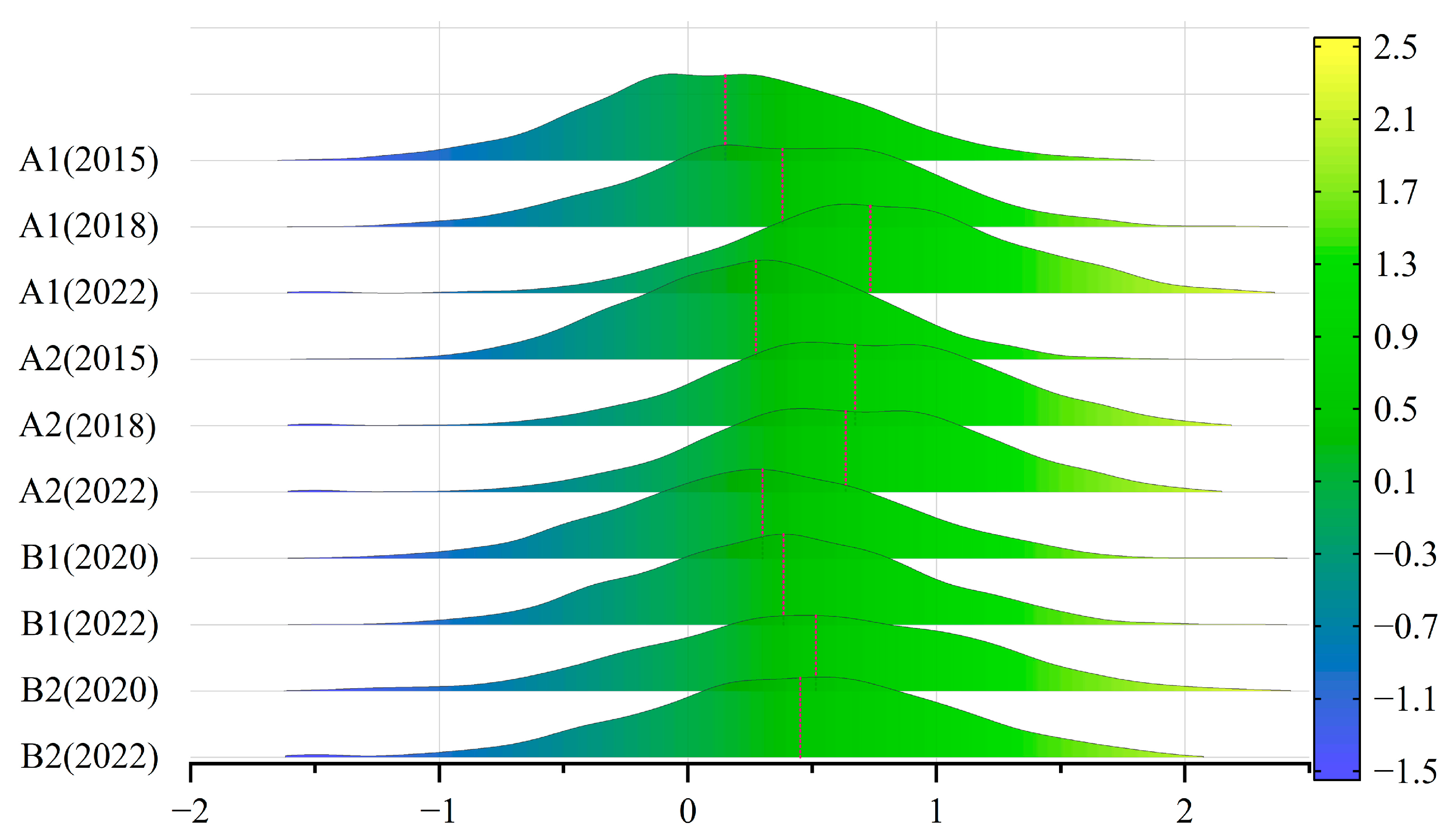
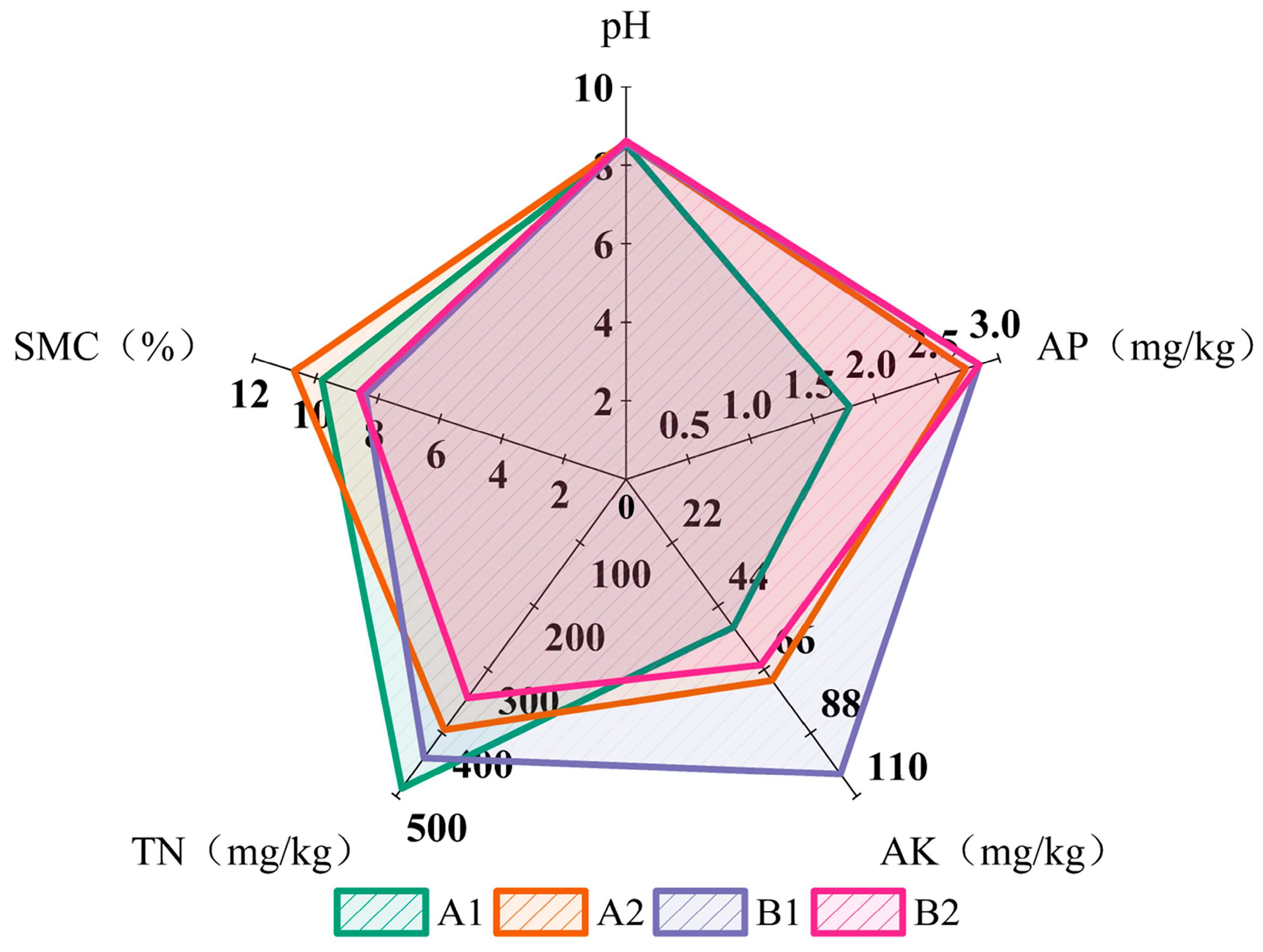
| Test Area | Mining Disturbance Time | Area | Ecological Restoration Measures |
|---|---|---|---|
| A1 | 2014 disturbance | 26.45 km2 | Tree planting |
| A2 | Undisturbed | 35.44 km2 | None |
| B1 | 2019 disturbance | 40.97 km2 | Fissure infilling; grass seeding |
| B2 | Undisturbed | 27.33 km2 | None |
| C | 2023 disturbance | 41.97 km2 | Fissure infilling; grass seeding |
| Indicator | Calculation Formula | Reference |
|---|---|---|
| NDVI | Tucker et al. (1979) [40] | |
| VFC | Carlson et al. (1997) [43] | |
| WET | Zawadzki et al. (2016) [44] | |
| NDBSI | Xu et al. (2008) [45] Essa et al. (2012) [46] | |
| LST | Jimenez-Munoz et al. (2009) [47] |
| Difference | Evolution Type |
|---|---|
| D ≤ −30% | Obvious degradation |
| −30% < D ≤ −15% | General degradation |
| −15% < D ≤ −5% | Slight degradation |
| −5% < D ≤ 5% | Stable |
| 5% < D ≤ 15% | Slight improvement |
| 15% < D ≤ 30% | General improvement |
| 30% ≥ D | Obvious improvement |
| Indicator | Measurement Method | Reference |
|---|---|---|
| Soil Moisture Content (SMC) | Gravimetric Method | Lide, David R. (2004) [48] |
| PH Value | Potentiometric Method | Ahluwalia, V.K. (2023) [49] |
| Total Nitrogen (TN) | Semi-micro Kjeldahl Method | Brabson, John A. (1966) [50] |
| Available Phosphorus (AP) | Olsen Method | Olsen, P.S. et al. (1954) [51] |
| Available Potassium (AK) | Flame Atomic Absorption Spectrophotometry | Christian, Gary D. et al. (1980) [52] |
| Indicator | Grading Criteria and Frequency | ||||||
|---|---|---|---|---|---|---|---|
| AP (mg/kg) | Abundance-Deficiency | Rich | Relatively Rich | Moderate | Relatively Deficient | Deficient | Extremely Deficient |
| Grading Criteria | >40 | 20~40 | 10~20 | 5~10 | 3~5 | <3 | |
| Frequency | 0 | 1 | 0 | 2 | 7 | 29 | |
| AK (mg/kg) | Grading Criteria | >200 | 150~200 | 100~150 | 50~100 | 30~50 | <30 |
| Frequency | 0 | 0 | 9 | 24 | 6 | 0 | |
| TN (g/kg) | Grading Criteria | >2.0 | 1.5~2.0 | 1.0~1.5 | 0.75~1.0 | 0.5–0.75 | <0.5 |
| Frequency | 0 | 0 | 0 | 1 | 20 | 18 | |
| pH | Acidity–Alkalinity | Strongly Acidic | Acidic | Neutral | Alkaline | Strongly Alkaline | Extremely Strong Alkalinity |
| Grading Criteria | 4.5~5.5 | 5.5~6.5 | 6.5~7.5 | 7.5~8.5 | 8.5~9.5 | >9.5 | |
| Frequency | 0 | 0 | 0 | 14 | 23 | 2 | |
| SMC (%) | Degree of Drought | Slightly Wet | Appropriate | Mild Drought | Moderate Drought | Severe Drought | |
| Grading Criteria | >20 | 15–20 | 12~15 | 5~12 | <5 | ||
| Frequency | 0 | 0 | 2 | 34 | 3 | ||
Disclaimer/Publisher’s Note: The statements, opinions and data contained in all publications are solely those of the individual author(s) and contributor(s) and not of MDPI and/or the editor(s). MDPI and/or the editor(s) disclaim responsibility for any injury to people or property resulting from any ideas, methods, instructions or products referred to in the content. |
© 2024 by the authors. Licensee MDPI, Basel, Switzerland. This article is an open access article distributed under the terms and conditions of the Creative Commons Attribution (CC BY) license (https://creativecommons.org/licenses/by/4.0/).
Share and Cite
Song, D.; Hu, Z.; Yu, Y.; Zhang, F.; Sun, H. Assessing Ecological Impacts and Recovery in Coal Mining Areas: A Remote Sensing and Field Data Analysis in Northwest China. Remote Sens. 2024, 16, 2236. https://doi.org/10.3390/rs16122236
Song D, Hu Z, Yu Y, Zhang F, Sun H. Assessing Ecological Impacts and Recovery in Coal Mining Areas: A Remote Sensing and Field Data Analysis in Northwest China. Remote Sensing. 2024; 16(12):2236. https://doi.org/10.3390/rs16122236
Chicago/Turabian StyleSong, Deyun, Zhenqi Hu, Yi Yu, Fan Zhang, and Huang Sun. 2024. "Assessing Ecological Impacts and Recovery in Coal Mining Areas: A Remote Sensing and Field Data Analysis in Northwest China" Remote Sensing 16, no. 12: 2236. https://doi.org/10.3390/rs16122236
APA StyleSong, D., Hu, Z., Yu, Y., Zhang, F., & Sun, H. (2024). Assessing Ecological Impacts and Recovery in Coal Mining Areas: A Remote Sensing and Field Data Analysis in Northwest China. Remote Sensing, 16(12), 2236. https://doi.org/10.3390/rs16122236







